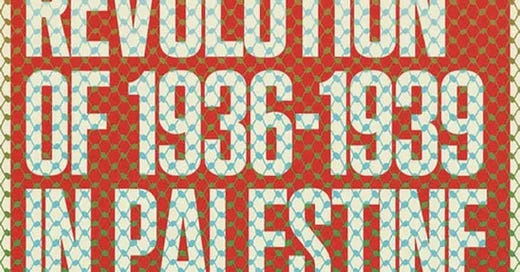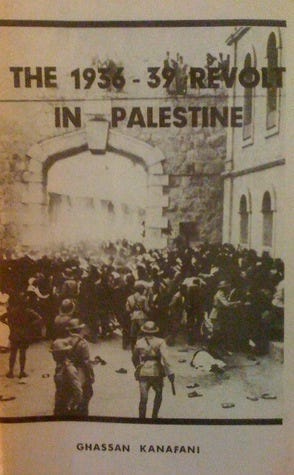The largest known boycott of the Zionist state’s cultural institutions is now underway: see this article for more information.
Ghassan Kanafani: The Revolution of 1936-1939 in Palestine—Background, Details, & Analysis, translated by Hazem Jamjoum, introduction by Layan Sima Fuleihan, afterword by Maher Al-Charie. New York: 1804 Books, 2023.
Last month, we marked the one-year anniversary of the Al-Aqsa Flood operation. Over the last 12 months, militant groups in Palestine have been waging a just war of national resistance (with tactical assistance from Iran and its proxy forces) against the Israeli invasion of Gaza that began on 27 October 2023. The war has expanded: Israel now fights Palestine and Hezbollah in Lebanon while taking fire from the Houthis and Iran.
The way in which the “rules based international order,” touted by our capitalist ruling cliques, was blithely tossed aside in complicity with Israel’s massacres in the region has delegitimized the major institutions of our society in the eyes of its youth. Students, teachers, public intellectuals, cultural workers have experienced appalling ideological repression. And if Palestine is fair game for censorship, what political question won’t be?
Our capitalist ruling clique does not like the shift in sympathy for Palestine, especially among younger Americans — you have to wonder if the ferociousness of pro-Israel messaging on campuses reflects this turn.
The punditry of the US now makes its postmortems on the 2024 general election. Harris promised there would be no change from Biden’s policy of support and facilitation for an intentional genocide — as they say, Fund a Genocide and Find Out.
All of Biden’s handwringing about the peace process was just to buy Netanyahu more time. Israel’s military machine is doing the US’s bidding: they are shaping the Middle East into Uncle Sam’s image without need for boots on the ground this time around. The difference between Dems and the GOP on foreign policy is purely quantitative: it’s a difference of degree of cultivation for imperialist propaganda.
The Democrats lost in a world-historical fumble of an electoral performance: but the electorate did not want Trump to win so much as wanted the centrist Dems to lose: suburbanites in the swing states who bought into the titanic importance of the 2020 election lost the Trump Mania fire this time — as they also say, You Can’t Fool the People Twice.
Harris is done speaking, but before she exits the stage we can reflect on her image as the perfect encapsulation of the vapid, blinkered, self-obsessed, hyper-identitarian urban petty-bourgeoisie and its ideological leadership of centrist liberalism, which even mainstream commenters now recognize is dead as a doornail. Good riddance.
Any sane party operative would look at these election returns and say, “Strike a match and start over.” So of course the college over-educated NGO rank and filers are engaged in blaming everyone but themselves, blaming Black and Latino voters, blaming pro-Palestine students, blaming Men as a species…their brain worms must be starving.
Given this horrendous situation, what is a literary left-winger to do?
The same thing I was doing when Trump’s first administration was confirmed in 2016: study, study, study!
There are arguments in the activism world that this is no time to read books when the situation is so dangerous. “What a useless literati these people are! Why can’t they go drop a banner or smash up a storefront? Isn’t this ableist and elitist?”
Well, was it elitist of the PFLP, the Marxist-Leninist section of the PLO, to be coordinating research centers and commissioning studies of a high intellectual and analytical order, carried out by intellectuals like Ghassan Kanafani (see a previous letter on his literary criticism)? —And all of this in the wake of the devastating military setback of 1967, with comrades hiding in safe houses throughout the Arab world?
Perhaps my anarchist colleagues know something that the historical fighting Arabs of Palestine didn’t. But in the meantime, the rest of this letter will focus on a 1969 historical study by Kanafani, that was part of precisely such a revolutionary research program. It came out in a new edition, and your host was impressed not just with the main body of the text, but the critical apparatus as well — and it has one of the best glossaries of the Israel-Palestine conflict I’ve ever seen.
In the introduction for this new edition of The Revolution of 1936-1939 in Palestine, Layan Sima Fuleihan frames the analysis Kanafani carried out in 1969 in the context of the PLO’s relocation to Lebanon after retreating from Jordan. The Cairo Agreement, brokered by Nasser, had just gone into effect: “an accord that acknowledged the sovereignty of the Palestinian resistance and its right to carry out operations from Lebanese soil, as well as its right to administer the daily life of the thousands of Palestinian refugees within Lebanese borders.”
At this turning point in the PLO’s military history, Kanafani looks at Palestine in the interwar period: at the time the territory was still a British Mandate. The British were interested in keeping a colony in Palestine to secure the Suez Canal. They systematically supported Zionist immigration, the settlers would serve as a buffer force against the Arab population. The Jewish population reached 370,000 by 1936. Foreign capital and British concessions flowed into Zionist private ownership, and Zionists bought up swathes of land from Arab feudal elites, and interlinked themselves with the colonial administration.
Arab peasants began resisting the oppression and provocations starting the 1920s, demanding an end to the colonization, the land purchases, the Zionist immigration, the abolition of the Mandate and Balfour Declaration, and national independence for the historical Palestinian territory.
The Arab Revolt began in earnest in the summer of 1929: workers, peasants, and urban petty-bourgeois organized to attack Zionist plantations and settlements. The imperialists put down these uprisings, but the movement had advanced enough politically that a delegation was sent to London to appeal for national independence in 1936. The British categorically refused to end the mandate. A new guerilla campaign began in the north of Palestine.
Kanafani periodizes the “Revolution” from 1936 to the start of WWII because of this escalation: this was when the Arab revolt became an Arab national war.
Kanafani’s short book is a concrete class analysis of the situation and forces at play in Palestine in 1936, in the Marxist tradition. On the first page he identifies the “triumvirate” of enemies, the chief obstacles to the national movement: reactionary Palestine leaders, Arab regimes surrounding Palestine, and the alliance between Zionism and imperialism.
Just a few pages later we get a concise passage, backed by statistical details, of how the national conflict sharped the class unity of Jewish and Arab workers. Labor Zionism consciously reserved employment for Hebrew-speakers, and created a national wage gap. This was all part of the plans of Zionism’s political project: exclude the indigenous from work opportunities and they’ll be forced to leave.
In other words, while the migration aimed to ensure that the agrarian-to-industrial transition of the “Palestinian” economy took place through capital concentrated in Jewish hands, it simultaneously aimed to provide this transition with a Jewish proletariat.
Kanafani points out the role of the Histadrut, the Zionist trade union federation (which made the news earlier this year calling a strike in Israel):
The Histadrut offers a clear formulation of the reality: “to allow Arabs access to the Jewish labor market would mean that Jewish capital would be directed toward Arab development and against Zionist objectives….
In discussing the peasantry — and the countryside was where the national struggle was sharpest — Kanafani highlights the “triple nightmare of Zionist colonization of the land, Arab feudal landownership, and the exorbitant taxation levied by the British Mandate government” that crushed the Arab peasantry, half of whom lived in grinding poverty.
This same dynamic preserved the oppression of the Arab landlords:
Colonialism — which threatened a way of life that encompassed aspects of religion, tradition and honor — enabled the feudal-clerical leaders to hold on to their positions of social leadership despite the crimes they continued to commit; in many cases, those same feudal elements buying the land from the smallholders went on to sell it to Jewish capital.
This is a general experience of the national bourgeoisie in oppressed nations. The relative dominance of the feudal-clerical class put them in a position to strive for more influence within the colonial system, but no further. And yet, to achieve their aims they must mobilize a mass of disenfranchised and desperate urban and agricultural workers. The balance invariably has fallen to the former, even when they manage to seize state power like in Cuba and Algeria. It’s the class composition of the neighboring Arab states that serves as the basis for Kanafani’s critique of them as well.
All the preceding only pertains to the introductory analysis of class forces. The description of the revolutionary sequence itself and aftermath are interesting, as is the afterword and glossary, which could stand alone as useful resources. This text is too brief and informative not to read and recommend for anyone taking concern with Palestinian national rights and the ongoing resistance.




